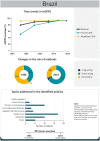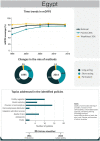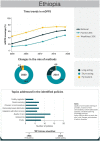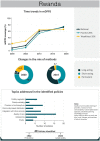Policies for expanding family planning coverage: lessons from five successful countries
- PMID: 38808004
- PMCID: PMC11131167
- DOI: 10.3389/fpubh.2024.1339725
Policies for expanding family planning coverage: lessons from five successful countries
Abstract
Background: Enhancing the design of family planning interventions is crucial for promoting gender equality and improving maternal and child health outcomes. We identified, critically appraised, and synthesized policies and strategies from five selected countries that successfully increased family planning coverage.
Methods: We conducted a policy analysis through a scoping review and document search, focusing on documents published from 1950 to 2023 that examined or assessed policies aimed at enhancing family planning coverage in Brazil, Ecuador, Egypt, Ethiopia, and Rwanda. A search was conducted through PubMed, SCOPUS, and Web of Science. Government documents and conference proceedings were also critically analyzed. National health surveys were analyzed to estimate time trends in demand for family planning satisfied by modern methods (mDFPS) at the national level and by wealth. Changes in the method mix were also assessed. The findings of the studies were presented in a narrative synthesis.
Findings: We selected 231 studies, in which 196 policies were identified. All countries started to endorse family planning in the 1960s, with the number of identified policies ranging between 21 in Ecuador and 52 in Ethiopia. Most of the policies exclusively targeted women and were related to supplying contraceptives and enhancing the quality of the services. Little focus was found on monitoring and evaluation of the policies implemented.
Conclusion: Among the five selected countries, a multitude of actions were happening simultaneously, each with its own vigor and enthusiasm. Our findings highlight that these five countries were successful in increasing family planning coverage by implementing broader multi-sectoral policies and considering the diverse needs of the population, as well as the specific contextual factors at play. Successful policies require a nuanced consideration of how these policies align with each culture's framework, recognizing that both sociocultural norms and the impact of past public policies shape the current state of family planning.
Keywords: Brazil; Ecuador; Egypt; Ethiopia; Rwanda; family planning; literature review; policy.
Copyright © 2024 Hellwig, Moreira, Silveira, Vieira, Rios-Quituizaca, Masabanda, Serucaca, Rudasingwa, Nyandwi, Mulu, Rashad and Barros.
Conflict of interest statement
The authors declare that the research was conducted in the absence of any commercial or financial relationships that could be construed as a potential conflict of interest.
Figures





Similar articles
-
Learning from success cases: ecological analysis of potential pathways to universal access to family planning care in low- and middle-income countries.Gates Open Res. 2023 Jan 20;6:59. doi: 10.12688/gatesopenres.13570.3. eCollection 2022. Gates Open Res. 2023. PMID: 36726686 Free PMC article.
-
Seminar on Egypt population policy.Demogr Afr. 1984;(22):29-49. Demogr Afr. 1984. PMID: 12313461
-
Unravelling factors influencing demand for modern contraception and evaluating coverage progress since 2015 in Ethiopia, Kenya, and Nigeria: insights from multilevel and geostatistical modelling.BMC Public Health. 2024 Jul 11;24(1):1855. doi: 10.1186/s12889-024-19387-9. BMC Public Health. 2024. PMID: 38992642 Free PMC article.
-
Prevalence and associated factors of client satisfaction with family planning service among family planning users in Ethiopia: a systematic review and meta-analysis.BMC Womens Health. 2023 Mar 30;23(1):151. doi: 10.1186/s12905-023-02300-8. BMC Womens Health. 2023. PMID: 36998000 Free PMC article.
-
Contraception in The Netherlands: the low abortion rate explained.Patient Educ Couns. 1994 Jul;23(3):161-71. doi: 10.1016/0738-3991(94)90032-9. Patient Educ Couns. 1994. PMID: 7971545 Review.
Cited by
-
Inequalities in contraceptive prevalence among married women of reproductive age in Sierra Leone, 2008-2019.Arch Public Health. 2025 Jun 18;83(1):158. doi: 10.1186/s13690-025-01653-w. Arch Public Health. 2025. PMID: 40533786 Free PMC article.
-
The role of restrictive abortion laws on modern contraceptive use in Sub Saharan Africa.PLOS Glob Public Health. 2025 Jul 10;5(7):e0004875. doi: 10.1371/journal.pgph.0004875. eCollection 2025. PLOS Glob Public Health. 2025. PMID: 40638672 Free PMC article.
-
Application of machine learning algorithms and SHAP explanations to predict fertility preference among reproductive women in Somalia.Sci Rep. 2025 Jul 20;15(1):26301. doi: 10.1038/s41598-025-04704-y. Sci Rep. 2025. PMID: 40685342 Free PMC article.
-
Contentious population policy-making and its consequences: a health policy analysis.Int J Equity Health. 2025 Apr 7;24(1):96. doi: 10.1186/s12939-025-02469-4. Int J Equity Health. 2025. PMID: 40197237 Free PMC article.
References
-
- Alkema L, Kantorova V, Menozzi C, Biddlecom A. National, regional, and global rates and trends in contraceptive prevalence and unmet need for family planning between 1990 and 2015: a systematic and comprehensive analysis. Lancet. (2013) 381:1642–52. doi: 10.1016/S0140-6736(12)62204-1, PMID: - DOI - PubMed
-
- Robinson WC, Ross JA. The global family planning revolution. Washington DC, USA: World Bank; (2007).
-
- Demeny P, McNicoll G. World Population 1950-2000: Perception and Response. Popul Dev Rev. (2006) 32:1–51. doi: 10.1111/j.1728-4457.2006.tb00002.x - DOI
Publication types
MeSH terms
LinkOut - more resources
Full Text Sources
Medical
Miscellaneous

